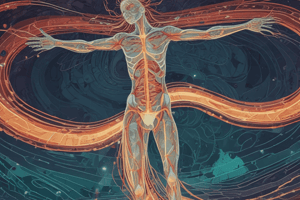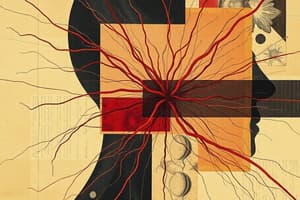Podcast
Questions and Answers
Which of the following is a pathological process associated with peripheral neuropathy?
Which of the following is a pathological process associated with peripheral neuropathy?
- Wallerian degeneration (correct)
- Hematoma formation
- Tendonitis
- Bone fracture
What are the primary components of the peripheral nerves?
What are the primary components of the peripheral nerves?
Numerous axons bound together by endoneurium, perineurium, and epineurium.
Which symptoms are commonly associated with peripheral neuropathy?
Which symptoms are commonly associated with peripheral neuropathy?
- Motor deficits (correct)
- Vision impairment
- Bone pain
- Sensory disturbance (correct)
What diagnostic test measures the speed of nerve conduction?
What diagnostic test measures the speed of nerve conduction?
Trigeminal neuralgia is typically a painless condition.
Trigeminal neuralgia is typically a painless condition.
What is the medical term for idiopathic facial palsy?
What is the medical term for idiopathic facial palsy?
What is the common treatment for trigeminal neuralgia?
What is the common treatment for trigeminal neuralgia?
What are typical clinical features of Bell's palsy?
What are typical clinical features of Bell's palsy?
What is a common cause of idiopathic facial palsy?
What is a common cause of idiopathic facial palsy?
Flashcards are hidden until you start studying
Study Notes
Overview of Peripheral Neuropathy
- Peripheral neuropathy involves damage to peripheral nerves, affecting sensory, motor, and autonomic functions.
- Key conditions include trigeminal neuralgia, idiopathic facial palsy, and Guillain-Barre Syndrome (GBS).
Anatomy of Peripheral Nervous System
- Comprises cranial nerves (excluding optic and olfactory), spinal nerves, and autonomic nerves.
- Peripheral nerves consist of multiple axons encased in three connective tissue layers: endoneurium, perineurium, and epineurium.
- Blood supply for peripheral nerves is provided by vessels located in the epineurium.
Pathological Processes
- Wallerian degeneration occurs following nerve injury, disrupting the axon.
- Axonal degeneration is linked to toxic or metabolic influences.
- Neuronal degeneration can result from conditions like poliomyelitis.
- Segmental demyelination can arise from GBS and diphtheria.
Symptoms of Peripheral Neuropathy
- Sensory disturbances, such as numbness or tingling.
- Motor deficits manifesting as weakness or muscle atrophy.
- Altered tendon reflexes, either reduced or absent.
- Autonomic disturbances, including changes in blood pressure or sweating.
- Miscellaneous symptoms like ataxia and musculoskeletal deformities.
Diagnostic Investigations
- Nerve conduction velocity (NCV) tests assess electrical activity in nerves.
- Electromyography (EMG) evaluates muscle response.
- Blood tests are conducted to check for underlying conditions.
- Cerebrospinal fluid (CSF) examination may reveal inflammatory changes.
- Nerve biopsy can provide histological insights into nerve structure.
Trigeminal Neuralgia
- Characterized by severe, electric-shock-like pain primarily in the V2 and V3 divisions of the trigeminal nerve.
- Pain episodes may last seconds to minutes, with trigger zones often located on the face.
- Rarely occurs during sleep, with long periods of pain-free intervals not typical.
- Diagnosis relies on clinical features with no definitive positive signs.
Treatment for Trigeminal Neuralgia
- First-line treatment includes antiseizure medications (AEDs) such as carbamazepine and phenytoin.
- Baclofen and Vitamin B12 may be used as adjunct therapies.
- Nerve blocks with agents like absolute alcohol or glycerol can provide relief.
- Surgical options are considered for refractory cases.
Idiopathic Facial Palsy (Bell’s Palsy)
- Presents with sudden, unilateral facial weakness or paralysis.
- Exact etiology remains unclear, but potential triggers include viral infections and environmental factors.
- Facial nerve comprises motor, sensory, and parasympathetic fibers, affecting facial movements and sensation.
Clinical Features of Bell’s Palsy
- Symptoms may include facial drooping, loss of ability to close the eye, and changes in taste sensation.
- Diagnosis is primarily clinical, focusing on symptom history and exclusion of other causes.
Treatment for Bell’s Palsy
- Corticosteroids are commonly administered to reduce inflammation.
- Supportive measures may include physical therapy to improve facial muscle function over time.
- Analgesics can help manage pain associated with facial nerve irritation.
Studying That Suits You
Use AI to generate personalized quizzes and flashcards to suit your learning preferences.




